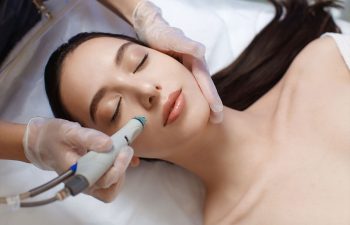
Pores are thousands of tiny openings on the skin. Some are sweat pores, which help your body regulate its temperature, but most are hair follicles, meaning they contain a small hair root and a sebaceous gland that produces your body’s natural oil (sebum). Sebum production is essential for skin health because it protects and moisturizes the skin. However, overproduction of sebum can lead to visibly enlarged pores due to the oil combining with skin debris.
Large pores are a common skincare complaint, ranking right up there with acne, wrinkles, and the overall signs of aging skin. They are a natural byproduct of oily skin and can appear dilated and visible to the naked eye. While large pores are a completely cosmetic problem, they can irritate the person who sees them in a mirror and often feel like they’ll never go away.
Unfortunately, you cannot open and close your pores on a whim—closing them would completely dry out your skin. Enlarged and clogged pores can make your skin look dull and unhealthy. Having congested pores can contribute to their large appearance, and the longer they’re clogged, the greater chance your pores have of becoming stretched out. It may even make you look older than you are, and, in some instances, it could also trigger severe acne.
CAUSES OF LARGE PORES
Everyone has the same number of pores, but some are more visible than others, especially around the nose, front part of the cheeks, and forehead. While some people are born with smaller pores, certain factors can impact their sizes, such as vitamin deficiencies, smoking, and hormonal differences. Other factors can determine the size of our pores, including:
- Genetics. Just like some people have blue eyes and others have brown, some people have small pores while others have large ones. If your parents have enlarged pores, there’s a high chance you will have them too. Genes can cause your skin pores to grow in size and open up around your T-zone—the forehead, nose, and chin—and your cheeks as well.
- Increased sebum production. Although sebum acts as a natural moisturizer for the skin, excess production is a big problem. Every pore contains a sebaceous gland that secretes sebum, so when they overproduce, the result is oily skin. The excess sebum collects on the skin’s surface, magnifying these tiny openings.
- Loss of skin elasticity. Our skin loses elasticity as we age, making our pores look bigger than usual. Enlarged pores are a natural part of the aging process, as collagen production in the skin starts reducing, making skin less firm. It also makes your skin look stretched and saggy.
- Sun damage. UV radiation has been shown to damage collagen production and elastin breakdown, a condition that’s often referred to as photoaging. Collagen production is important in keeping your skin firm and healthy. Furthermore, sun damage can trigger sagging around the edges, thereby reducing the water levels in the skin.
- Large hair follicles. Every hair has a follicle, and every hair follicle is positioned under a pore. When hair follicles are large, your pores will also be large!
If you want to reduce the size of your pores, minimally invasive cosmetic procedures can help diminish their visibility.
NEUROTOX FOR LARGE PORES
In traditional cosmetic Neurotox treatments, the deeper muscle groups of the face are targeted, particularly in the forehead, between the eyes, and around the mouth. This prevents patients from making facial expressions that lead to the appearance of dynamic wrinkles. However, for pore reduction, intradermal Neurotox for large pores is not injected into the muscles that target facial expression.
Instead, it is injected into the arrector pili, or fine muscles in the skin attached to hair follicles that cause them to protrude from the skin at the surface: the pore. Therefore, injecting Neurotox in this manner contracts the skin’s pores, resulting in a smaller skin surface area. In addition, Neurotox can prevent recurring acne breakouts due to its ability to reduce excessive skin oil production.
In most cases, intradermal Neurotox treatments last around four months, with some patients experiencing the benefits of treatment for up to six months. Results, however, do not last forever, so once the effects of an initial treatment have worn off, patients can undergo an additional Neurotox injection to prolong the aesthetic results.
Once dull, dead skin cells are removed, your skin will look brighter, smoother, and more even. It will feel softer, too, giving you a beautiful, poreless matte finish. This can help with general facial aesthetics and improve the look of your makeup when applied. In addition to Neurotox for pore reduction, daily cleansing and regular facials are essential to keep the pores as clean as possible.
Whenever you’re ready to erase the look of enlarged pores, visit Beverly Hills Aesthetics to browse our different Beverly Hills acne treatments and Neurotox procedures that can help you achieve the look you desire. You can also schedule a complimentary virtual consultation with Dr. Sam Assassa for more information.
We’ll be waiting!
Posted on behalf of
640 South San Vicente Blvd Suite# 410
Los Angeles, CA 90048